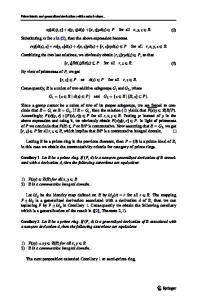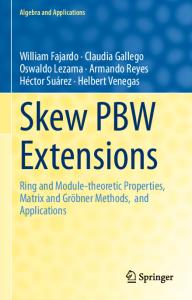Rings in which every nonzero weakly prime ideal is prime
- PDF / 1,150,254 Bytes
- 9 Pages / 439.37 x 666.142 pts Page_size
- 39 Downloads / 424 Views
Rings in which every nonzero weakly prime ideal is prime Abdelhaq El Khalfi1 · Najib Mahdou1 · Youssef Zahir1
© Instituto de Matemática e Estatística da Universidade de São Paulo 2020
Abstract In this paper, we study WP-ring, that is a ring in which every nonzero weakly prime ideal is prime. Some results including the characterizations and the transfer of WPring property to homomorphic image and localization are given. Also, we study the possible transfer of the WP-ring property between A and A ∝ E and between A and A ⋈f J . Our results provide new classes of commutative rings satisfying the above property. Keywords WP-ring · Trivial ring extension · Amalgamation of rings along an ideal Mathematics Subject Classification Primary 13B99 · Secondary 13A15 · 13G05 · 13B21
1 Introduction The notion of prime ideal plays an important role in commutative ring theory. Several generalizations of the concept of a prime ideals are studied in literature, as examples: almost prime, strongly prime and weakly prime. In this paper we will be mostly interested to weakly prime ideals introduced by Anderson and Smith [2]. Though the notion of weakly prime ideals has been extensively studied (see, for instance, [1, 2, 9]).
Communicated by Sergio R. Lòpez-Permouth. * Najib Mahdou [email protected] Abdelhaq El Khalfi [email protected] Youssef Zahir [email protected] 1
Modelling and Mathematical Structures Laboratory, Department of Mathematics, Faculty of Science and Technology of Fez, University S.M. Ben Abdellah Fez, Box 2202, Fes, Morocco
13
Vol.:(0123456789)
São Paulo Journal of Mathematical Sciences
Before recalling some results, let us introduce some notations, definitions and useful facts. Throughout this paper, all rings will be √commutative with identity element, and all modules are unitary. If A is a ring, 0 denotes the set (ideal) of all nilpotent elements of A; Reg(A) denotes the set of all regular elements of A; Ann(I) denotes the annihilator of an ideal I. If A is an integral domain, we denote its quotient field by qf(A). Following [2], a proper ideal P is said to be weakly prime ideal if, whenever a, b ∈ A and 0 ≠ ab ∈ P , then a ∈ P or b ∈ P . Let consider a weakly prime ideal P of a ring A. Then for any a ∈ A whose class, ā ∈ A∕P is nonzero, the canonical map:
AnnA (a) ⟶ AnnA∕P (̄a) is surjective.Also, recall from [2, Theorem 4] that if P is a weakly prime ideal in A which is not prime, then one has √ √ P ⊂ 0 ∩ Ann( 0) In particular, P2 = 0. Clearly, every prime ideal is weakly prime, but the converse is not true in general. For example, the zero ideal is weakly prime (by definition) but is not prime unless the case of integral domain. There is no investigation on the following natural question: when are every nonzero weakly prime ideal is prime? For this, it is could be interest to study a class of rings satisfying the above question. Here, we focus our attention to this study instead of class of rings in which every weakly prime ideal is prime. In fact, this last class has no inte
Data Loading...











